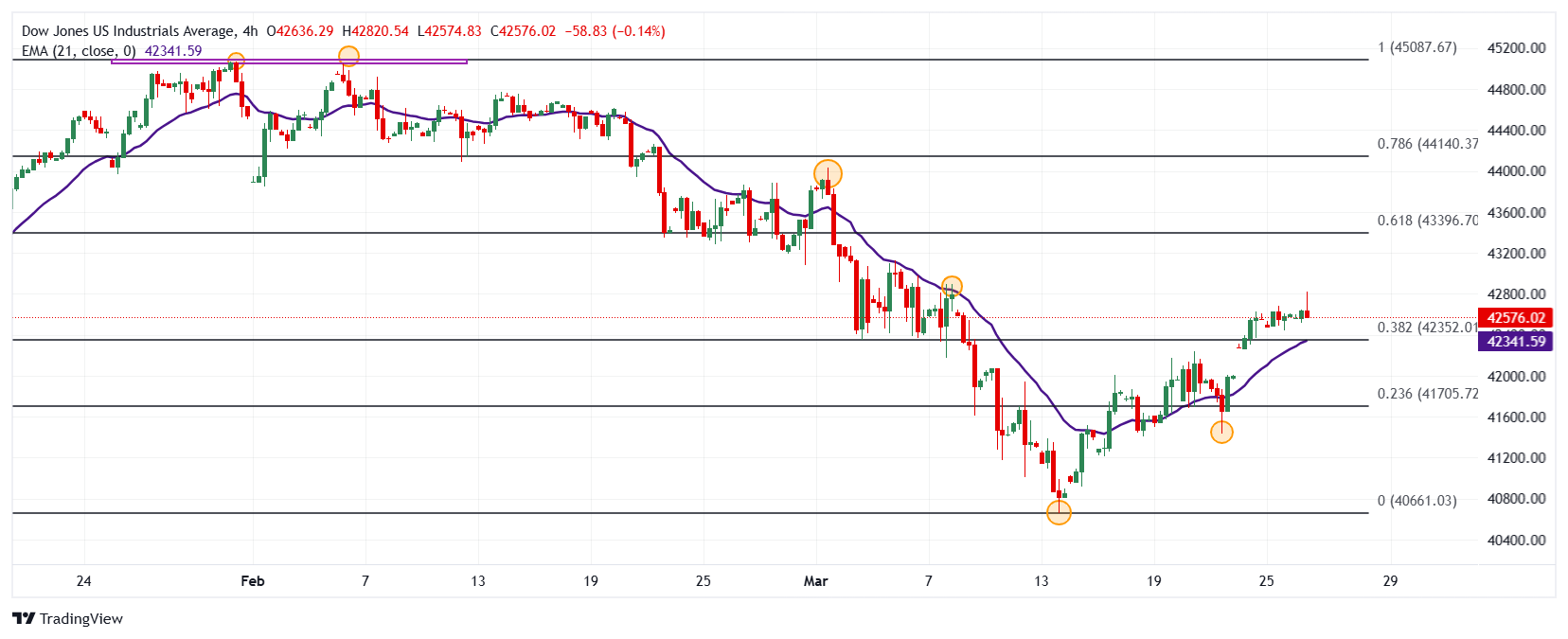- The Dow Jones wins 0.05% in the day, operating at the time of writing at 42,607.
- The Nasdaq 100 falls 1.08% daily, today, dragged by Applovin Corporation (app) and Marvel Technology (MVL).
- The S&P 500 decoced 0.57% on Wednesday, reaching minimums of March 24.
- The requests for durable goods increase by 0.9% in February, improving the expectations of analysts.
- The look of investors will be on the Gross Domestic Product of the United States, to be published tomorrow.
The Dow Jones established a minimum of the day in 42,515, where buyers attracted that promoted the maximum index of March 7 in 42,820.
The Dow Jones industrial average began negotiations at 42,560 while the Nasdaq 100 technological index opened at 20,279. The S&P began operating in 5,772, going back to minimums of March 24.
UnitedHealth and McDonald´s Coporaction keep Dow Jones in the profit zone
The Dow Jones index rises 0.05% of Wednesday’s day, winning 70 points, currently quoting over 42,607.
The actions of McDonald’s Corporation rise 1.56% today, reaching maximum of March 11 at $ 312.59, spinning three consecutive days with profits.
Following the upward perspective, the Titles of UnitedHealth have a daily gain of 1.16%, exceeding maximum of February 18 in 522.95 $.
In this context, the Dow Jones signs its fourth consecutive day upwards, consolidating at maximum of almost three weeks.
APPLOVIN TORPORTION AND MARVELL TECHNOLOGY track the NASDAQ 100 to negative field
The Nasdaq 100 technological index loses 1.08% on Wednesday, reaching minimum of March 24 at 20.028.
The values of Marvell Technology (MRVL) collapse 5.39% daily, reaching March 11 at 67.24 $, signing two consecutive sessions down.
In the same tonic, the APPLOVIN CORPORATION (APP) shares decrease 4.57% reaching levels of March 24 in $ 326, ending with a streak of five consecutive days with profits.
The Nasdaq 100 leads the losses between the main American shareholders, going back to minimum of two days, operating at the time of writing at 20,075.
The S&P 500 quotes with losses after the tariff threats of Donald Trump
The president of the United States, Donald Trump, announced yesterday the imposition of copper tariffs in the coming weeks surprising the financial markets.
After this news, the S&P 500 has a fall of 0.57% today, cutting a streak of five consecutive days upwards, quoting currently about 5,742.
On the other hand, the requests for lasting goods rose 0.9% in February, improving estimates of a 1% contraction, although below the 3.3% rise recorded in January.
The focus of the operators will be tomorrow on the gross domestic product corresponding to the fourth quarter of the United States, the consensus of analysts expects to be located in 2.3%, matching the record of the previous quarter.
Technical Analysis of Dow Jones
The Dow Jones established a short -term support given by the minimum of March 21 in 41,431. The following key support is observed in 4,660, pivot point of March 13. To the north, the closest resistance is located at 44,033 maximum of March 3.
4 -hour graph of Dow Jones

Dow Jones Faqs
The Dow Jones Industrial Avenge, one of the oldest stock market indexes in the world, consists of the 30 most negotiated values in the United States. The index is weighted by the price instead of capitalization. It is calculated by adding the prices of the values that compose it and dividing them by a factor, currently 0.152. The index was founded by Charles Dow, also founder of the Wall Street Journal. In recent years it has been criticized for not being sufficiently representative, since it only follows 30 companies, unlike broader rates such as S&P 500.
There are many factors that promote the Dow Jones Industrial Average (DJIA) index. The main one is the added performance of the companies that compose it, revealed in the quarterly reports of business benefits. The American and world macroeconomic data also contribute, since they influence investor confidence. The level of interest rates, set by the Federal Reserve (FED), also influences the DJia, since it affects the cost of credit, on which many companies depend largely. Therefore, inflation can be a determining factor, as well as other parameters that influence the decisions of the Federal Reserve.
Dow’s theory is a method to identify the main trend of the stock market developed by Charles Dow. A key step is to compare the direction of the Dow Jones Industrial Avenge (DJIA) and the Dow Jones Transportation Average (DJTA) and just follow the trends in which both move in the same direction. The volume is a confirmation criterion. The theory uses elements of maximum and minimum analysis. Dow’s theory raises three phases of the trend: accumulation, when intelligent money begins to buy or sell; Public participation, when the general public joins the trend; and distribution, when intelligent money abandons the trend.
There are several ways to operate with the DJ. One of them is to use ETF that allow investors to negotiate the DJ as a single value, instead of having to buy shares of the 30 companies that compose it. An outstanding example is the SPDR Dow Jones Industrial Avenge ETF (day). Future contracts on the DJ allow the specular operators about the future value of the index and the options provide the right, but not the obligation, to buy or sell the index at a predetermined price in the future. Investment funds allow investors to buy a part of a diversified portfolio of DJ values, which provides exposure to global index.
Source: Fx Street
I am Joshua Winder, a senior-level journalist and editor at World Stock Market. I specialize in covering news related to the stock market and economic trends. With more than 8 years of experience in this field, I have become an expert in financial reporting.







